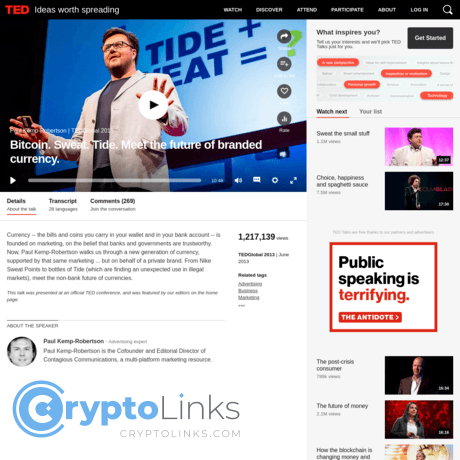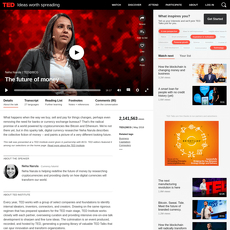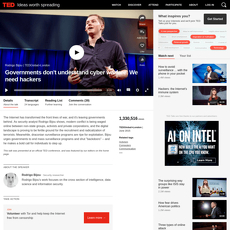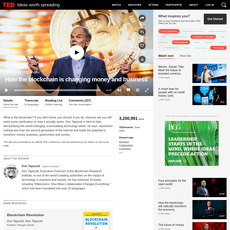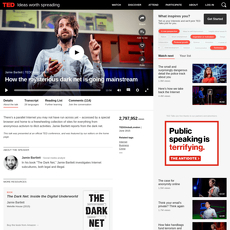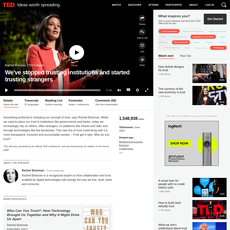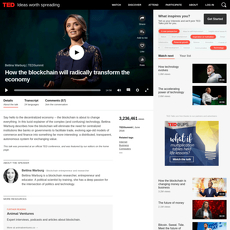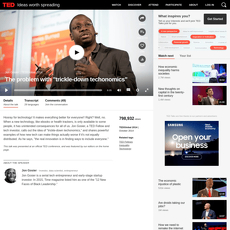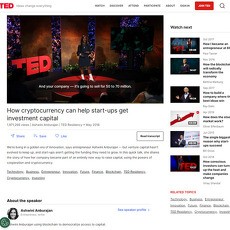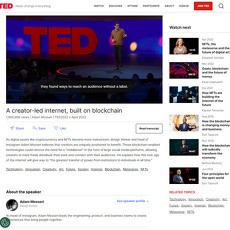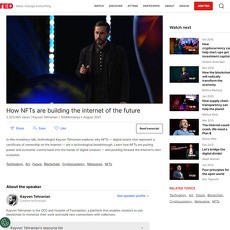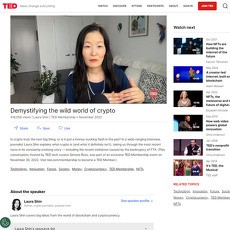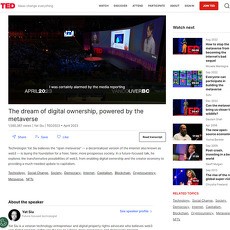Paul Kemp-Robertson: Bitcoin. Sweat. Tide. Meet the future of branded currency. Review
Paul Kemp-Robertson: Bitcoin. Sweat. Tide. Meet the future of branded currency.
www.ted.com
Paul Kemp-Robertson: Bitcoin. Sweat. Tide. Meet the future of branded currency — review guide, everything you need to know with FAQ
Could you imagine paying with points, detergent, or your steps the same way you use cash? That’s the (surprisingly practical) idea behind Paul Kemp-Robertson’s TED talk, “Bitcoin. Sweat. Tide. Meet the future of branded currency.” If you’ve ever wondered whether brand-issued value is real money or just marketing fluff, you’re in the right place.
I watched the talk again with 2025 eyes and pulled together what still matters, what changed, and how to actually use these ideas without getting burned. No jargon, no pep rally — just what works in the real world.
On Cryptolinks.com, I keep things simple: if it’s not useful, it’s not in here.
The problems this talk raises (and why people get stuck)
“Branded currency” sounds cool, but it triggers a lot of fair questions. Here are the sticking points I hear most — and the ones this guide clears up:
- Is it real money or just points? People know loyalty programs, but they want to know if this stuff holds value outside the app. Starbucks, for example, consistently reports over a billion dollars sitting in prepaid balances and rewards — functionally store cash — yet you can’t pay your rent with it. That tension is the heart of the debate.
- The TED talk is from crypto’s early days. What survives in 2025? Short answer: a lot. Stablecoins went mainstream for payments and remittances, while “points-as-money” exploded in apps and games (think Robux on Roblox). But the rules and risks are clearer now — and tougher.
- Is this even legal? People worry about securities rules, money transmitter licenses, and tax. They’re right to. Loyalty is fine; “invest in our token for profit” without compliance is not. And what you can do in the EU under MiCA isn’t identical to the US, UK, or Asia.
- How do you spot a legit brand currency vs. a gimmick? Some programs are basically coupons in a new wrapper. Others are truly useful currencies inside an ecosystem. The difference shows up in redemption, liquidity, and clear rules — not shiny token tickers.
“Money is what people trust and can spend.” The brand part only works if both boxes are checked.
What I’ll help you solve here
- What Paul really means by “branded currency.” Not just buzzwords — a simple definition you can use to test any proposal.
- How the idea maps to 2025. Where stablecoins, loyalty tokens, fan tokens, and move‑to‑earn fit (and where they don’t).
- Straight answers to questions you actually Google. From legality and taxes to redemption and exit paths.
- A quick framework to judge “brand money.” Whether you’re a user, a marketer, or an investor, you’ll know what to check first.
What you’ll get from this guide
- Plain‑language breakdown of the talk’s biggest points — no vague hype.
- Clear lines between Bitcoin, stablecoins, and brand‑issued value, so you’re not mixing apples and tokens.
- Real examples that work (airline miles, retail rewards, some fan tokens) and ones that fizzled because people couldn’t redeem anything useful.
- A short checklist to spot value, risk, and compliance red flags before you spend a cent.
Curious why a detergent brand is in the title — and what that says about trust and money? Up next, I’ll explain exactly what “branded currency” means in this talk, how it works, and why the Tide example still matters today. Ready to see the simple test that separates real utility from hype?
What “branded currency” means in this TED talk
Here’s the punchline of Paul Kemp-Robertson’s idea: if people trust a brand, and that brand gives you something you can earn, spend, and redeem with clear rules, it starts to feel like money. It’s not about printing banknotes with a logo. It’s about issuing value that works in the real world because the promise behind it is strong.
“Money is trust you can actually use.”
Think loyalty points, platform credits, gift cards, and some tokens. Most don’t look like cash, but once you can trade them for flights, coffee, skins, or seats at a game—and you trust they’ll be honored—the brain files them under “money‑ish.”
So… what is branded currency?
I use “branded currency” to mean value created and governed by a company or platform—points, credits, or tokens that live inside an ecosystem (and sometimes with partners). It works only if three things click: trust, utility, and redemption.
- Issuer: a brand sets the rules (earn, spend, expiry, transfers).
- Unit + ledger: balances tracked in the brand’s system (not always on a blockchain).
- Utility loop: clear ways to earn and spend—ideally often and in more than one place.
- Redemption promise: what you can get, when, and at what rate.
- Trust signals: reputation, transparent terms, and predictable value.
Real‑world snapshots that make this concrete:
- Airline miles (AAdvantage, MileagePlus): these aren’t just perks; they’re economic engines. Airlines have even used them to secure multi‑billion‑dollar financings—proof that markets treat them as real assets with cash flow and redemption value. See investor hubs like United and American Airlines for past disclosures.
- Starbucks Stars: a closed‑loop currency that millions of people earn and redeem daily. Check Starbucks IR—you’ll see membership counts in the tens of millions and rewards driving a significant share of U.S. store sales. Frequent redemption keeps the “Star” feeling like spendable value, not just a number on a screen.
- Roblox Robux: platform money for a digital world. Players buy Robux to spend; creators can convert Robux back through the Developer Exchange. That exit door (even if controlled) turns points into something closer to an earnable currency inside the ecosystem.
- Mobile value in emerging markets: before regulated mobile wallets took off, people informally treated airtime and SMS top‑ups as money because they were transferable and widely accepted. Development groups like CGAP have documented how utility + network effect make non‑cash balances behave like cash.
Notice the thread running through all of these: you believe the brand will honor the redemption, you can use the balance where you live your life, and the rules aren’t a black box. That’s why some brand‑issued value feels spendable while others gather dust.
Is Bitcoin a branded currency?
No. Bitcoin isn’t owned by anyone—no company, no marketing team, no help desk. It’s open, decentralized, and permissionless. Branded currencies, by contrast, are centralized by design. They live or die on the issuer’s promise and the usefulness of the things you can actually get.
- Issuer: Bitcoin has none; brand currency has a company setting the rules.
- Governance: Bitcoin changes by community consensus; brand currency changes when the issuer updates terms (think mileage chart updates).
- Value basis: Bitcoin’s value is market‑driven; brand currency is anchored to redemption (a flight seat, a latte, a skin).
- Access: Bitcoin is borderless; brand currency usually sits inside an app, store, or partner network.
That doesn’t make branded currency “lesser”—it makes it different. It’s closer to store credit that can range from tiny and niche to massive and liquid, depending on how well the issuer runs the system.
Why is “Tide” in the title?
Because the talk points to a wild but telling example: in certain U.S. gray markets, bottles of Tide detergent became a kind of trade token—recognizable, consistent, and always resellable. Street value plus universal brand recognition turned a household product into an informal store of value people swapped for other goods.
It’s not an endorsement of that market; it’s a lens on human behavior. When something is trusted, easy to recognize, and everyone agrees it’s worth about X, it starts acting like money—even if nobody planned it that way. We’ve seen the same pattern with cigarettes in prisons or mobile airtime balances before formal e‑money rules caught up. Utility + trust + a shared story about value. That’s the core.
If you’re thinking, “Okay, but does this still hold up in 2025 now that we’ve got stablecoins, fan tokens, and tighter rules?”—great question. In the next section, I test these ideas against today’s reality: what aged well, what didn’t, and where the risks show up when the music stops. Want the frank version?
Does the talk hold up in 2025? What’s right and what’s off
“Money is what we trust, use, and expect others to accept tomorrow.” That was the heartbeat of Paul Kemp‑Robertson’s talk — and in 2025, it still hits. But the real world added some sharp edges: regulation, redemption risk, and the boring (but vital) accounting that decides who actually wins.
What Paul got right
On the big calls, he was early — and right.
- Loyalty and platform credits turned into serious money inside ecosystems. Starbucks has consistently reported well over $1.5B in stored value on its cards and app — effectively interest‑free float and a closed‑loop currency you can earn and spend daily. Check their 10‑K filings for the liability that proves the point (Starbucks annual reports).
- People accept non‑government value if it’s useful and easy. Stablecoins are the clearest example. There’s now over $150B worth circulating, used for payments, trading, remittances, and payroll in crypto‑forward companies (DeFiLlama stablecoin data). That’s not theory — that’s daily behavior.
- Brand/Fan tokens work when perks are real. Sports tokens on Socios/Chiliz landed because fans could actually get closer to the club — voting on experiences, getting presale access, merch discounts. When rewards are claimed, the “token” stops being a lottery ticket and becomes a utility pass.
- Identity + mobile made value portable. Apple/Google wallets, QR rails, and country‑scale systems like India’s UPI normalized instant, low‑friction payments. That same UX expectation now applies to brand‑issued value — if it’s clunky, it dies.
What needed caveats
Here’s where the TED stage optimism meets the real 2025 sandbox.
- Compliance is the game board, not a footnote.
- KYC/AML rules kick in fast if value is transferable, bought/sold, or moveable across borders. In the US, think FinCEN “money transmitter” obligations and state licenses; in the EU, MiCA now defines how crypto assets — especially stable/pegged ones — can be offered.
- Securities risk shows up the moment you hint at profits. The SEC’s Howey framework has already sunk big‑name token launches that looked like investments (see Telegram and Kik cases).
- Consumer rules matter even for “points.” Gift‑card style programs in the US fall under the CARD Act and CFPB gift card rules (limits on expiry/fees: CFPB Reg E §1005.20). Promos aren’t a free‑for‑all.
- Volatility and custody aren’t “crypto‑only” problems anymore. If a brand token trades on chain, users face market swings, wallet risk, and bridge risk. Airdrop hype fades; safe storage and predictable exits matter. The hard truth: if people can’t hold it safely and redeem it quickly, they won’t keep it.
- Liquidity and redemption decide trust.
- Liquidity: Fan tokens often moon on launch then fade; the fan token market has seen multi‑year drawdowns. Without steady demand from real perks, price action turns into a billboard for disappointment.
- Redemption: Clear, fast, and multi‑partner redemptions are the moat. When programs sunset or devalue quietly, users remember. Airline miles remain strong because the partner network is deep and earn/spend is predictable — even if devaluations sting.
- Breakage and liability live on the balance sheet. Under IFRS 15/ASC 606, points are a deferred revenue liability until redeemed. “Breakage” (unredeemed value) can’t just be wished away; it’s recognized based on historical patterns and must be disclosed (see IFRS 15). Translation: if you issue value, you inherit long‑term obligations. That changes how aggressively you can “give away” rewards.
- Friction kills small redemptions. If fees spike (think L1 gas), a $2 coffee reward feels useless. That’s why many brands now choose L2s or app‑native ledgers with periodic settlement. Design choices are product choices, not IT details.
Is branded currency legal?
Yes — inside the right lanes.
- Loyalty, prepaid, and promotional credits are allowed in most markets when you set clear terms, publish redemption paths, and follow consumer protection laws. In the US, gift‑card style products have guardrails on expiry/fees (see CFPB guidance).
- Transferability changes the rules. Letting users trade or cash‑out can trigger money transmission (US state MTLs, FinCEN registration) or e‑money rules (EU). Under MiCA, fiat‑pegged designs may be “e‑money tokens,” requiring authorization and reserve/audit duties.
- Don’t market it like an investment. Promises of profit or “we’ll buy back higher” bring securities law into play. If your token walks and talks like a yield product, expect regulators to treat it as one.
- Taxes exist even if the app feels like a game. In many places, users owe tax when rewards are redeemed for value; issuers face VAT/sales tax questions on redemptions and accounting for breakage. Local advice matters here more than hot takes.
Bottom line: trust + utility made branded value feel like money — but in 2025, compliance, redemption, and accounting decide who scales and who stalls.
If you’re thinking, “Alright — so how do I build or use this without getting burned?”, you’re exactly where I want you. Next up, I’ll share the practical playbook: a short, ruthless checklist for brands, users, and investors that cuts through hype and shows you what actually works. Ready for the cheat sheet?
Practical takeaways for brands, users, and investors
I’ve watched too many “brand money” launches sizzle on day one and stall by day thirty. The difference between a currency and a gimmick always comes down to trust, utility, and exits. You want the playbook? Here’s the straight‑up version I use when I evaluate these programs.
“If people can’t spend it or get out, it isn’t currency — it’s captivity.”
For brands and marketers
You don’t need a token to create value. You need a loop people actually use.
- Start with utility, not tech. Map your day‑1 and week‑4 redemptions. If users can’t earn and spend in the same week, you’re building breakage, not loyalty. Good benchmark: coffee‑style rewards (think Starbucks Rewards) where small, frequent redemptions keep the flywheel spinning.
- Publish simple rules. Plain‑English terms, caps, and redemption windows. No dark patterns. If there’s a peg (e.g., 100 points = $1), say it and explain when you can change it.
- Design the “minimum viable currency.”
- Earning: purchases, referrals, UGC, early reviews.
- Spending: discounts, upgrades, access (priority support, presales), and partner perks.
- Time to first redemption: target under 7 days. Programs with fast first redemption show higher 90‑day retention across retail and travel loyalty.
- Build partners from day zero. Closed loops plateau. Airline miles work because of deep alliances and card partners (e.g., Amex transfers into multiple programs). Even a modest partner network (gift cards, rideshare credits, streaming months) dramatically lifts perceived value.
- Offer exits. One off‑ramp beats ten slogans. Options:
- Cash‑like redemption at checkout (real discounts, not sweepstakes).
- Partner gift cards as a pressure valve (with guardrails).
- On‑chain tokens? Integrate a regulated off‑ramp or stablecoin swap. If users must go “peer‑to‑peer in a Telegram group,” you don’t have an exit.
- Guard against inflation. Tie issuance to revenue or verifiable actions. Hard caps or season‑based emissions stop your currency from turning into confetti. “Earn‑to‑earn” models without sinks typically crash once speculation fades.
- Make accounting and compliance boring (in a good way).
- Classify as loyalty/prepaid; avoid profit‑promise language.
- Honor refund logic: if a purchase is refunded, reverse the points/credits.
- Respect regional rules: gift‑card laws, KYC/AML if transferable, tax handling on issuance vs redemption.
- Be transparent with data. Live dashboards help trust: units issued, redeemed, breakage %, partner count, and any treasury backing if you claim a peg.
- Real examples to copy (and what to learn):
- Airline/hotel points: strong partners and clear earn/spend. Lesson: clarity beats novelty.
- Starbucks Rewards: frequent low‑value redemptions make it feel “liquid.” Lesson: short path to first win.
- Fan tokens (e.g., Chiliz): engagement perks matter more than price charts. Lesson: perks users claim are the product.
Quick builder checklist (pin this on the wall):
- What can a user buy or unlock today?
- How fast can they redeem the first time?
- Is supply/emissions public and predictable?
- Who are the first five partners and the first exit?
- What’s the process if you ever shut it down? Spell it out now.
For crypto users
Think of most brand tokens like store credit until proven otherwise.
- Check the redemption page before you earn or buy. Look for: what you can get today, any blackout dates, minimums, fees, and expiry. If the page feels vague, that’s your sign.
- Test the exit with $5–$20. Can you actually redeem or convert without hoops? If not, don’t pre‑fund a closed loop.
- Watch for devaluations. Points can change overnight. Programs sometimes “reprice” rewards. Keep balances lean and redeem often if the issuer has a history of changes.
- Custody and control. On‑chain token? Use a wallet you control and verify contract addresses. Off‑chain points? Screenshot balances after big earns; keep emails/receipts in case of disputes.
- Separate utility from speculation. Fan tokens and “move‑to‑earn” apps can be fun, but treat market price as a bonus, not a plan. If your excitement relies on “number go up,” you’re speculating.
- Privacy still matters. Some programs track redemption to ad profiles. Check what data you hand over when you connect a wallet or account.
- Red flags I avoid:
- Promised yields with no clear revenue source.
- No published terms or a confusing “points math.”
- All upside talk, zero info on exits or support.
- Reality check examples:
- Starbucks Odyssey sunset (2024): even big brands can stop experiments. Always ask: what happens to my balance if this pauses?
- Move‑to‑earn apps: great for motivation when rewards buy real goods; weak when it’s only a token chart. Spend what you earn; don’t hoard.
For investors and builders
Judge these as payment products with token rails, not token tickers with a payment story.
- Track the right KPIs:
- DAU/MAU with a redemption event, not just logins.
- Earn‑to‑burn ratio: target >60% of issued value redeemed within 30–60 days early on.
- Time to first redemption and repeat redemption rate (core loyalty health).
- Partner count and partner GMV attributed to the currency.
- On/off‑ramp coverage and average slippage/fees on exits.
- Unit economics over vibes. What’s the acquisition cost per earning user? Does redemption lower churn, increase AOV, or lift margin via mix shift? If not, the token is a marketing expense without a return.
- Supply policy you can underwrite. Hard caps, scheduled emissions, or revenue‑linked minting. Manual, opaque mint buttons are a non‑starter.
- Compliance posture. Is it positioned as loyalty/prepaid, with clear non‑investment language? Are transfers limited or monitored to avoid money transmitter/securities issues? Where needed, is KYC embedded?
- Security signals: smart‑contract audits, on‑chain allowlists for redemption, fraud tooling, and a published incident response plan. If there’s a treasury/peg, look for attestation or audit cadence.
- UX matters. One‑tap redemption beats a 7‑step wallet ritual. Friction kills spend velocity, then token price follows.
- Fast heuristics I use:
- If users don’t spend it, it isn’t a currency — it’s a collectible.
- If exits depend on hype, it ends when the chart does.
- If the CFO can’t explain the liability, expect a “temporary pause” announcement later.
- Case cues:
- Airline ecosystems: rich data shows higher LTV when points are redeemed within 30 days of earn. That’s the pattern you want.
- Fan tokens: engagement KPIs (claimed perks, voting participation) predict resilience better than price ROI.
I’ve got a stack of quick answers coming next — including “Are loyalty points taxable?”, “What’s the real difference between a brand token and a stablecoin?”, and “Can a company legally create its own currency without getting in trouble?” Curious which one will save you money this month?
FAQ — quick answers to what people ask about this talk and branded currency
“Trust is the oldest currency. Technology just speeds it up.”
What does “branded currency” actually mean?
It’s value issued by a company that you can earn and spend inside its ecosystem (and sometimes with partners). Think of it as programmable store credit with rules you can read.
- Loyalty points: airline miles, hotel points, Starbucks Stars
- Platform credits: Robux, V-Bucks
- Brand tokens: sports/fan tokens that unlock perks, access, or discounts
The key is redemption. If I know how to earn it, where to spend it, and how it’s governed, it starts to feel like money inside that network.
How is this different from Bitcoin or stablecoins?
- Bitcoin: no company, no central issuer, open to anyone, volatile, permissionless.
- Stablecoins: issued by a company but pegged to fiat (e.g., $1), designed for transfer and settlement.
- Branded currency: issued by a company for utility and loyalty. Not always pegged, often non‑transferable outside the ecosystem.
A Starbucks Star is closer to store credit than a dollar; a USDC coin is closer to a digital dollar than a coffee point.
Was Tide really used like money?
The talk uses Tide as a striking example: a recognizable, in‑demand product that people traded like cash in certain contexts because it was trusted and easy to resell. That’s the lesson — when something is trusted and widely accepted, it behaves like money even if it wasn’t meant to.
If you want the original context, watch the TED talk. The point isn’t “use detergent as currency.” It’s that trust + acceptance = value in motion.
Are loyalty points “money”?
Inside the network, functionally yes. In the eyes of the law, no — they’re not legal tender. They’re a contractual claim against the issuer with rules that can change.
- You can redeem miles for flights and upgrades, but the airline can devalue the chart.
- You can swap Stars for coffee, but they may expire or get reset for inactivity.
Reality check: these programs are massive. Airlines even used them as collateral. In 2020, major U.S. carriers raised billions backed by their loyalty programs — a signal that points have real, measurable value to businesses and customers.
Can brands legally create their own currency?
Yes, within existing rules. Most branded “money” is classified as loyalty, promotional credit, or prepaid value. Where brands get into trouble is when they:
- Promise profits or “investment” upside (can trigger securities rules)
- Enable public transfer or cash-out without money transmitter compliance
- Hide terms, expiry, or redemption limits (consumer protection issues)
If you’re building, read up on local rules. The EU’s MiCA sets the crypto sandbox in Europe; in the U.S., state money transmitter laws, the SEC/FTC, and tax rules are the usual gatekeepers.
What are the risks for users?
- Devaluation: points or tokens suddenly require more to redeem the same reward
- Expiry and inactivity: value evaporates if you don’t use it
- Blacklists and bans: account closures kill your balance
- Liquidity traps: can’t cash out or transfer; stuck in a closed loop
- Issuer risk: brand shutters the program or changes terms overnight
If you’ve ever watched your miles “move the goalposts,” you know the sting. I always ask: how do I exit if I need to?
How do I earn or buy brand tokens?
Most brands want you to earn by using the product: purchases, engagement, referrals, quests, or fitness goals.
- Earn: buy coffee, book flights, hit workout streaks, complete in‑app tasks
- Buy: some programs sell points/credits directly; tradable tokens may be listed on exchanges (subject to local rules)
- Bundle: credit cards and partners often let you earn faster via multipliers
Tip: if buying, sanity‑check the redemption math. Paying $20 for value you can only redeem for $12 of perks is… not a deal.
Will branded currencies replace cash?
Unlikely. They’ll live alongside cash, bank money, and stablecoins. Branded value wins inside ecosystems where it actually makes life easier:
- Fast, predictable redemptions (coffee, rides, game items, upgrades)
- Strong partner networks (air + hotel + retail)
- Transparent rules and fair earn/burn rates
I see the stack like this: cash/stablecoins for the open world, and brand currency for things you do often with the same company.
Want to see which programs actually deliver? In the next section I break down real examples — from airline miles that behave like blue‑chip assets to fan tokens that only work when perks get claimed. Which ones would you trust with a month of your spend?
Examples and case studies worth watching
Let’s get practical. Here’s what’s actually working in the wild, what fizzled, and what to copy if you’re building or judging a branded currency today.
Classic loyalty as currency
Airline miles and hotel points are still the blueprint. They’re not crypto, but they prove the core point: if people trust the issuer and can reliably redeem, it behaves like money inside the network.
- United MileagePlus: United used its loyalty program as collateral for a roughly multi‑billion dollar loan in 2020, implying the program alone is worth tens of billions. Translation: these points are a real asset with predictable redemption demand.
- Delta SkyMiles: The co‑brand credit card partnership brings in billions a year for Delta. That’s not hype; it’s proof that a closed‑loop currency with strong earn/spend rails can be a profit center.
- Marriott Bonvoy: Massive partner web and global redemption. Yes, dynamic pricing and devaluations happen, but users keep engaging because redemption paths are clear (rooms, upgrades, transfers).
Coffee and retail rewards show the opposite edge of the spectrum: small, frequent redemptions that build habit.
- Starbucks Rewards: Tens of millions of active members; a large share of U.S. sales runs through Rewards. Why it works: instant earn, fast spend (free drink/food), and constant feedback loops inside the app.
- Lesson you can steal: micro‑redemptions beat big‑bang rewards. If your currency can buy something useful every week, users feel the value and keep the loop alive.
If people can’t predict value or redeem fast, they stop treating it like currency and start treating it like a coupon they’ll forget.
Brand and fan tokens
The best fan tokens tie to perks people actually claim. The worst are just price charts with team logos.
- Socios/Chiliz (PSG, FC Barcelona, and many others): Utility that works in practice includes vote‑on‑club decisions, ticket lotteries, VIP access, and merch discounts. The catch: if the perks are sporadic or hard to redeem, trading dominates and most fans don’t bother.
- What to watch: redemption rates and perk inventory. If only a tiny fraction of holders ever redeem for experiences or discounts, it’s not a fan currency—it’s a speculative instrument with a sports wrapper.
- Platform credits as a control group: look at Roblox Robux. Not a token, but a brand currency with clear flows: users buy Robux, creators earn them and can cash out via DevEx. That two‑sided economy (earn AND exit) is what many fan tokens still miss.
Takeaway: If your token’s “utility” is just governance polls and the same hoodie discount every quarter, expect churn. Limited, high‑demand perks (tickets, meet‑and‑greets, guaranteed allocations) move the needle; everything else is noise.
“Sweat” economy and move‑to‑earn
Fitness‑for‑rewards can work, but only when the rewards are spendable and the emission schedule doesn’t drown the market.
- STEPN: Required NFT sneakers to earn tokens from walking/running. Huge early growth, then classic inflation pain as rewards outpaced sinks. The lesson isn’t “don’t do it”—it’s match emissions to real sinks (repairs, upgrades, event passes) and tie rewards to branded partners users actually want.
- Sweatcoin / SWEAT: Minted from verified steps with a marketplace of offers and, in some regions, a token off‑ramp. The model works when the marketplace is stocked and the app throttles issuance to protect value. When either lags, users treat it like a novelty and walk away.
Design rules that keep these alive:
- Day‑one redemption for real goods/services (not just a leaderboard).
- Partner rewards that aren’t infinitely printable (limited stock, curated drops).
- Emissions that scale with demand, not with hype.
What makes a “good” branded currency
Here’s the pattern I look for when I decide whether to join, build, or pass.
- Clear earning and spending loops: Users know exactly how to earn and can redeem without hoops.
Example: Starbucks Rewards—earn stars, trade them for a drink on your next visit. - Partner network: One brand is fine; a network is better. More places to spend means more reasons to hold and earn.
Example: Airline alliances and hotel partners turbocharge redemption. - Published supply/rules: How much exists, how fast it’s issued, when it expires, and how devaluations are handled.
Example: Top loyalty programs publish charts or dynamic bands; reputable stablecoins publish attestations (if you’re pegging, audit the backing). - User‑friendly off‑ramps: If not fiat, then at least partner redemptions or swaps.
Example: Roblox lets creators cash out; strong loyalty lets you transfer to partners for flights/rooms. - Real utility beats novelty: Perks people brag about after they redeem.
Example: VIP ticket experiences for fan tokens; guaranteed product drops for retail brands. - Compliance baked in: KYC/AML where needed, clear T&Cs, consumer protections, tax reporting for rewards when applicable. Users shouldn’t need a lawyer to understand it.
One more sanity check: if you removed the price chart tomorrow, would people still care? If the answer is no, it’s not a currency—it’s a collectible hoping to become one.
Want a dead‑simple checklist to judge any of these in under two minutes—and the questions I ask founders before I join a program? Stick with me; that’s next.
My verdict: how to use this talk today
Here’s the simple lens I use now: branded currency only works when three things line up — trust, utility, and a clean way out.
Money = trust + utility + exits.
That’s why some programs feel like real value and others feel like coupons with extra steps. Airline loyalty shows what “currency-grade” looks like: deep partners, constant redemption, and durability. American Airlines even used its AAdvantage program as collateral to raise roughly $10B in 2020 — that’s how tangible these liabilities are to markets. On the flip side, when programs sunset without strong exit paths, users pay the price. Starbucks shut down Odyssey (its web3 beta) in 2024, and Reddit ended Community Points in 2023; both are reminders that your “brand money” is only as good as the redemption policy and shutdown plan.
So yes — the talk still hits. It’s your mental model for choosing, building, or ignoring brand-issued value in 2025.
Who should watch and what to look for
Marketers
- Start from the redemption moment, not the mint. If users can’t spend it in under a minute, it’s dead on arrival. The loyalty research is consistent: members who redeem are the ones who stick and spend more. Make redemptions frequent and meaningful (small wins + occasional “wow”).
- Build partners first. Think airline alliances and co-branded cards — not a walled garden. Map a network where users can earn in one place and burn in many.
- Ship clear rules: supply caps, earn/burn rates, devaluation policy, and a transparent ledger (on-chain or auditable server-side). Ambiguity kills trust faster than volatility.
- Plan the off-ramp. Even closed-loop credit should have a safety valve: convert to gift card value, stablecoin rails for compliant programs, or a defined cash-out with fees and limits.
Crypto users
- Treat most brand tokens like store credit until proven otherwise. Ask: where can I spend this today? What’s the expiry? Can the issuer freeze or slash balances?
- Check the shutdown policy. When Reddit sunset Community Points, token utility evaporated overnight. Look for a written exit plan and a grace window.
- Don’t overfund closed systems. Keep balances near what you’ll spend in the next 30–60 days unless there’s real, liquid off-ramps.
Builders
- Compliance by design. If it’s transferable or pegged, you’re flirting with e-money or securities territory depending on jurisdiction. Document your classification and controls before launch.
- Design for day-one utility. A token with no spend path isn’t a currency — it’s a collectible. Seed at least 3 meaningful redemption options at launch.
- Publish a real-world value map: partners, categories, and average redemption value. Then track and share KPIs like redemption rate and time-to-first-redemption.
- Assume sunsets happen. Bake in “convert-to-X” fail-safes, plus a funded reserve for redemptions during wind-down.
Quick action checklist
- What’s the utility on day one? Name the first three things users can buy or unlock. If you can’t, you don’t have a currency yet.
- Where can users redeem (and how fast)? Time-to-redemption should be under 60 seconds and five taps. Redemption should exist both online and IRL, or via clear partners.
- Is supply clear and capped? Publish total supply or issuance rules. If there’s a peg (e.g., 1 token = $1 value), show audited reserves or on-chain proofs with monthly attestations.
- Are terms, KYC/AML, and tax obvious? Post plain-language T&Cs, country restrictions, and any reporting. Silent compliance is a red flag; clarity is a moat.
- What’s the exit path if the brand shuts down? Spell out conversion options (gift card, stablecoin, cash-out), a funded redemptions window, and how users will be notified.
- What metrics prove it’s real? Track redemption rate, partner count, average value per redemption, time-to-first-redemption, and breakage. If redemption shrinks while issuance grows, value is quietly devaluing.
Conclusion — watch it, then build smarter
Use the talk as a practical filter. Brands can create value that behaves like money when they pair trust with everyday utility, ironclad clarity, and legal footing. That’s how you get the upside of loyalty without the headaches of hype.
Want the source that kicked all this off? Watch Paul Kemp‑Robertson’s TED talk here: Bitcoin. Sweat. Tide. Meet the future of branded currency.
Reality checks and receipts worth skimming:
- American Airlines financed billions on the back of AAdvantage — proof these liabilities are economic reality, not buzzwords.
- Reddit’s sunset of Community Points shows why exit plans matter.
- Starbucks ending Odyssey in 2024 reminded everyone that brand experiments end — strong redemption beats speculation every time.
- If you’re building for Europe, get smart on MiCA; classification drives design.
I’ll keep tracking the branded money experiments that actually help users — and flag the ones that won’t. If something new launches with real utility, you’ll see it here on Cryptolinks.com. If it’s just a token with a PR budget, you’ll know that too.

